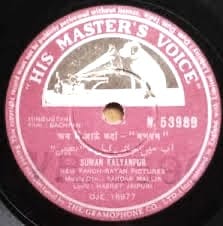The Evergreen Code: Why Classic Hindi Film Music Still Outsings the Present

What Naushad, Hasrat Jaipuri, Rafi, Lata, Kishore, and Mukesh Reveal About Culture, Memory, and Meaning.
The Paradox
Streaming platforms spend billions. Labels optimize for algorithms. Marketing is louder than ever. Yet when families gather—from Mumbai to Karachi to Kuala Lumpur to Toronto—the playlist tilts back to the “old” songs. People rise to their feet for black-and-white melodies. Children who don’t speak Hindi or Urdu can hum every line. No one is embarrassed; everyone is proud.
This isn’t just nostalgia. It’s sociology, psychology, and anthropology—set to music.
The Golden System: A Craft Ecology, Not a Content Factory
Between the 1940s and 1970s, Hindi cinema evolved a craft ecology that produced durable songs:
- Composer–poet duos (Naushad–Shakeel Badayuni; Shankar–Jaikishan with Hasrat Jaipuri and Shailendra; S.D./R.D. Burman with Majrooh; Madan Mohan with Raja Mehdi Ali Khan) worked like research labs, not assembly lines.
- Song as scene: music wasn’t glued on; it carried plot, character, and emotion—so it was written to be remembered.
- Hybrid grammar: raga/ghazal/thumri/qawwali structures blended with Western harmony/orchestration: melodies with internal logic and mass singability.
- Voice as instrument: Rafi’s pliant range, Lata’s luminous line, Kishore’s conversational charisma, Mukesh’s grain of pathos—timbres you can identify in one note.
- Lyric density: the Urdu–Hindi literary register (radeef/qaafiya, metaphor, meter) gave songs semantic depth. A Hasrat Jaipuri couplet could carry more meaning per bar than many modern hooks do per album.
Result: music that wasn’t merely catchy; it was coherent—structurally, poetically, dramatically.
Why It Endures: Three Sciences Behind “Evergreen”
Sociology (Ibn Khaldūn’s Lens: ʿAsabiyyah)
Ibn Khaldūn argued that civilizations rise on social cohesion (ʿasabiyyah), then soften in comfort. Golden-era film music overlapped a high-cohesion phase: post-colonial nation-building, radio cinema culture, and studios where Hindu/Muslim/Sikh/Parsi/Christian artists co-created. Songs became civic glue—common property across class and creed. Diasporas later adopted them as portable homelands.
Psychology (How the Brain Latches On)
- Melodic contour & predictability reward anticipation with mild surprise.
- Prosody fit (lyric stress = melodic stress) makes lines feel inevitable.
- Emotion tagging via mukhda–antara repetition binds feeling to phrase.
- Timbre imprinting: distinct voices act like fingerprints—instant recognition.
Anthropology (Ritual and Transmission)
Classic songs are woven into rites of passage—mehndi, sangeet, reunions, national days. Repetition in ritual = cultural hard drive. Because they narrate moral universals (longing, loyalty, duty, play), they travel across languages and generations.
What Changed: Platforms, Incentives, Attention
Today’s scene isn’t “worse,” but incentives differ:
- Platform logic favors instant hooks over long arcs.
- Loudness/compression boosts streamability, reduces dynamic breath.
- Fragmented authorship can outrun composer–poet intimacy—we lose handwriting.
- De-narrativized cinema: when songs stop advancing story, they lose narrative memory.
The golden corpus remains evergreen because it was forged under different cultural constraints and higher literary expectations.
Four Microscopes: What the Classics Do That Sticks
Devotional Gravitas
Naushad-era bhajans or semi-classical pieces anchor on tonic, explore raga contour, and resolve like “homecoming.” Theological humility pairs with musical resolution: the brain learns resolution = relief.
Romantic Restraint
Mid-century love songs use metaphor (chaand, saavan, mehfil) that invites listener participation. We remember what we co-author.
Conversational Drama
Kishore’s phrasing sits like dialogue on melody—quotable song: say it or sing it, it lands either way.
Pathos With Dignity
Mukesh’s timbre carries ache without self-pity. Laments are written with moral agency (I chose, I lost, I accept), so sadness feels noble, not indulgent.
Why the “Evergreen” Keeps Renewing: Culture as a Living Archive
- Intergenerational pedagogy: families teach songs like parables.
- Remediation: covers, reality shows, tributes keep the archive live.
- Linguistic hospitality: non-Hindi/Urdu listeners absorb affect first, decode words later.
- Shared moral grammar: yearning without vulgarity, devotion without dogma, joy without sneer—an appealing moral middle.
Answering the Money Question
Then: fewer screens, slower cycles—replay value was king; songs had to last on radio for months.
Now: content abundance, fragmented attention—click value wins; longevity is optional.
The old system accidentally engineered long-term cultural fitness. The new one optimizes short-term platform fitness. Evergreen songs win the long game.
A Khaldūnian Coda: Cycles and Renewals
When ʿasabiyyah thins, art risks becoming ornamental—technique without meaning. Renewal begins when artists resolder community and purpose. We already see pockets of revival: live strings/winds, metaphor-rich lyrics, voice culture and diction, songs reintegrated as story rather than insert. When craft realigns with cohesion, music ages well again.
What Today’s Creators Can Borrow (Without Imitating the Past)
- Reunite Composer + Poet so melody and meaning grow together.
- Write for Scenes—even in non-film music, make songs tiny stories.
- Honor Prosody—if the line sings awkwardly, the brain won’t keep it.
- Let Dynamics Breathe—silence improves replay value.
- Aim for Intergenerational Dignity—romance without cringe, devotion without sermon, joy without sneer.
The Verdict
Old Hindi film music was made by systems that prized melody, poetry, voice, and meaning as co-equals. It endures because it optimizes for the mind’s architecture, the family’s rituals, and the community’s conscience—not just this week’s chart.
That’s why a Naushad cadence, a Hasrat Jaipuri metaphor, a Rafi glide, a Lata line, a Kishore wink, a Mukesh sigh still feel like home—even to those who never lived in the house.
Evergreen isn’t about age. It’s about design.
About the Author
Alfie Ameer is the Founder & CEO of Vonfidel Group (VFG) and Chair of Vonfidel Ranch and VONFIDEL K9.
Through Cognisive Consultants, he writes on the intersections of culture, psychology, and leadership, exploring how societies build — and lose — trust, meaning, and memory.
A lifelong admirer of Hindi film music and classical poetics, he studies the deeper architectures of art and civilization — from Naushad’s orchestral humanity to Ibn Khaldūn’s sociology of cohesion.
© 2025 Cognisive Consultants | A Vonfidel Group (VFG) Company
Published via insights.cognisive.co
info@vonfidel.com

